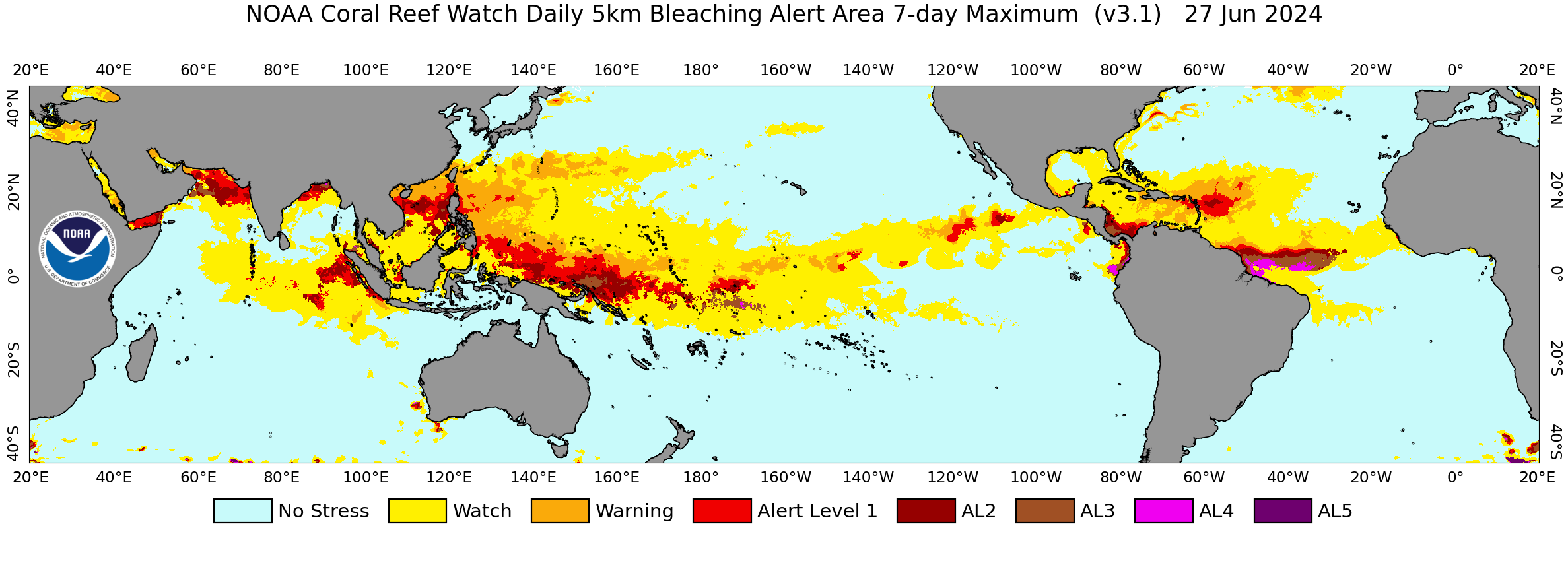Coral reefs
are one of Earth's most diverse ecosystems. They provide
significant
ecological, economic, and societal benefits valued, globally, at about USD$9.8 trillion each year
(de Groot et al.
2012![]() ,
Costanza et al.
2014
,
Costanza et al.
2014![]() ).
Unfortunately, reefs worldwide are threatened by an increasing array of impacts, primarily from
bleaching heat stress,
unsustainable fishing practices,
and land-based pollution.
).
Unfortunately, reefs worldwide are threatened by an increasing array of impacts, primarily from
bleaching heat stress,
unsustainable fishing practices,
and land-based pollution.
First observed in the early 1980s, mass
coral bleaching (whereby corals bleach over a wide area that can span tens, hundreds,
or even thousands of kilometers) has become one of the most visible and damaging marine
ecological impacts of persistently rising ocean temperatures. Bleaching is the process by
which corals lose the symbiotic algae that give them their distinctive colors and main
energy sources. If a coral is severely bleached,
disease and death become likely. Severe coral bleaching has become
more extensive, frequent, and intense. This can be seen in the acceleration of heat
stress events that cause mass bleaching, and in new multi-decadal bleaching observation
datasets. As manifested by the devastating
2014-2017 global coral bleaching event (now considered the
longest, most widespread and most damaging coral bleaching event on record![]() ),
mass bleaching events around the globe are often lasting many months; are becoming an
annual event; and are impacting coral reefs that never bleached before. It's clear that
remotely monitoring coral reefs and providing actionable intelligence are critical for
early detection, on-the-ground response, communication, and enhancing coral reef resilience.
),
mass bleaching events around the globe are often lasting many months; are becoming an
annual event; and are impacting coral reefs that never bleached before. It's clear that
remotely monitoring coral reefs and providing actionable intelligence are critical for
early detection, on-the-ground response, communication, and enhancing coral reef resilience.
To address a defined need of coral reef managers around the world, NOAA established the Coral Reef Watch (CRW) program in 2000. For more than 20 years, NOAA CRW has utilized remote sensing, modeled and in-situ data to predict, observe, and alert users globally to threats to the coral reef environment. The near real-time satellite products and modeled Outlooks that comprise CRW's global early-warning system of coral reef environmental changes have successfully and accurately predicted and monitored all major mass coral bleaching events observed globally since 1997, and have provided other critical information to users, especially during periods of severe ocean heat stress.
NOAA CRW serves all coral reef ecosystem managers with custodial duties for tropical coral reefs; in-water coral reef monitoring networks; the private sector (including scuba diving operators); scientific researchers at universities and research organizations; educators; students; and the public. An extensive and diverse community of users regularly apply NOAA CRW's modeled predictions and near real-time satellite-based heat stress products to support conservation, restoration, and resilience-based research and management projects that aim to protect and/or restore coral reefs.
Users apply NOAA CRW products to monitor and predict detrimental impacts to coral reefs worldwide; understand links between environmental conditions and ecosystem impacts; assess when reefs are vulnerable or resilient to warming ocean and its impacts (especially coral bleaching and disease); and prepare and prioritize resources to implement timely, effective protective responses and adaptation actions, thereby improving coral reef management and regulation. Coral bleaching response plans, incident action plans, and restoration plans around the world rely on NOAA CRW's Bleaching Alert Levels (recently expanded, in December 2023, to include Bleaching Alert Levels 3-5, in response to the extreme marine heatwaves of 2023), to assist with or help guide planning and implementation of work by in-water monitoring and management networks, including in emergency situations. In response to CRW's modeled predictions, satellite products, early warnings, and frequent communications, users have reduced local stressors during periods of high ocean heat stress and extreme marine heatwaves, including by closing major scuba diving and fishing areas. They also have rescued rare corals; shaded/cooled key nursery reefs; and conducted emergency, in-water operations to remove corals from local reefs and nearshore nurseries and house them, temporarily, in offshore and land-based nurseries. In times of low or no marine heat stress, users also apply CRW products to identify appropriate locations for, and then implement, conservation and restoration initiatives, to give transplanted corals or corals grown in-situ the best chance at survival. Learn more about the impacts of NOAA CRW's work here.
NOAA CRW is uniquely qualified to provide essential environmental intelligence. Its extensive partnership network with data providers, scientists, and coral reef managers allows CRW to leverage key partner efforts in the U.S. and internationally, to undertake research to develop the best possible products for its users, and to better understand how stakeholders use its tools. CRW works closely with its users and partners throughout product conceptualization, research, development, implementation, testing/enhancement, and operationalization. CRW provides training domestically and internationally in appropriate product use/application and to garner feedback to improve management tools. This allows NOAA to provide a better understanding of environmental threats to coral reefs and establishes sound practices for the use of CRW's information to enhance resilience-based coral reef management.
CRW sits within the National Environmental Satellite, Data, and Information Service (NESDIS) Center for Satellite Applications and Research (STAR), and is a part of the NOAA Coral Reef Conservation Program (CRCP) matrix.
CRW's satellite products are a key component of NOAA's monitoring efforts for coral reef ecosystems, including the National Coral Reef Monitoring Program.
Click here for a brief history of the early years (1997-2007) of the NOAA CRW program. (Note that this is a PDF of the story that was originally featured on the "NOAA Celebrates 200 Years of Science, Service, and Stewardship" website. That archival website is currently offline and unavailable.)
